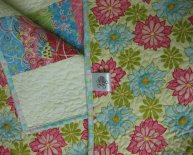
Where to Buy bolts of fabric?
Please note that this applies to fabric for production. I realize that not everyone has the option to buy full bolts wholesale when they’re first starting out or even know how to buy wholesale fabric . This post is intended to help you understand that the fabric store is not a long term strategy. For many, it’s not even a short term option. Read on to see where you fit in.
1. Continuity
You have no guarantee that fabric you buy at the store (or from a jobber) will be available if you need to reorder. If you want to guarantee supply, you’ll be forced to tie up money to buy fabric for a product that may not sell through. Experienced practitioners design based on sample fabrics and then order for production if sales interest is sufficient (the process is explained in my book). It’s hard enough to make a go of this without tying up your capital in aging fabric inventory. Seen eBay lately? That’s where everyone who went broke are offloading their inventory.
2. Off trend
Fabric at retail is usually on the downward slope of trends. If you’re making fashion items, it may not look dated to you but it will to anybody else you’d hope would buy from you. Fabric store fabric has a very short shelf life; it’s designed for immediate consumption because it will expire soon if it hasn’t already. Shopping at DIY outlets (farmer’s markets, Etsy etc) is a bit of an inside joke. To the experienced eye (wholesale buyers see a lot of product) it is very easy to pick out items made from retail fabric. It is close to impossible to generate wholesale orders with a retail based supply chain. If a buyer knows you can’t or don’t know how to buy wholesale, how can they commit a portion of their budget to buy your stuff? Even if they love your concept, they won’t be confident enough to invest in your line because they think you won’t make delivery.
3. Out of sync with the fashion calendar
There is a good 9 month lag between ordering fabric samples for your designs and six months in ordering fabric for production (if sales justify it). To sell at wholesale, you need to be in sync with upcoming trends but designing for future delivery with fabric you buy today, guarantees your stuff will look dated as compared to your competitors, six to nine months from now. Large brands subscribe to trend bureau services but that is pricey for those starting out. Happily, most wholesale garment fabric suppliers subscribe so you can ride on their coat tails and save yourself some money on fashion forecasting.
4. Licensing
Some fabric at retail is licensed for consumer use, only because given fabric brands sell wholesale licenses to manufacturers of finished products intended for retail consumption. A good example is Disney. Disney licenses their property to a textile manufacturer who licenses the fabric to (for example) Diaper Bags R Us. Say you come along and make diaper bags of the store bought Disney fabric to sell to other people, Diaper Bags R Us is going to be unhappy and Disney will come after you because you’re infringing on the rights they sold to Diaper Bags R Us. If they don’t go after you, Diaper Bags R Us aren’t going to buy a license anymore and believe me, Disney makes more on manufacturers than they make on a retail bolt here and there. Sure you can litigate your rights to use the fabric as you see fit but good luck. If you had the money to win that battle, you would have had the money to license from Disney in the first place. Pick your poison.
5. So you thought it was wholesale
Many start ups are savvy enough to figure out that they need wholesale so they go to certain wholesale fabric shows that are easy to find (read: designed to be found easily) but not all wholesale is created equal. Specifically, you don’t want to attend wholesale shows that are intended for fabric store owners! You’re better off going to a wholesale show intended for the garment industry. Not only does it cost less but all of the colors, prints and textures are fresher. These aren’t hard to find. People from Fashion-Incubator arrange to meet up at every show so you wouldn’t have to go alone.
6. Folded fabric CANNOT be spread on industrial equipment
The put up of your fabric is the biggest reason of all; fabric that is folded in half and wound on pieces of flat cardboard cannot be spread in a production environment. The only fabric that sewing factories can work with is fabric that is rolled on tubes (ROT). All of our equipment, machines, markers etc, are designed for flat lays of fabric, not folds. The only businesses that will work with flat folded fabric are corner sewing shops; businesses that sew prom gowns and hem pants for the public. These may be a great way to start because they’re accessible and easy to find but their services are very, very expensive by comparison. If not in fees, then in fabric waste. Few of these businesses can afford long tables that use fabric efficiently.
7. Crease fades
Fabric folds fade because the folded edge takes more wear and exposure while stored and displayed. The folded edge ages much more quickly than goods to the inside. Again, this may not be obvious at the outset, especially to a neophyte but it is usually apparent after a consumer has washed the item a time or two. Again, fabric stores sell aging inventory in more than one respect.
8. Cost.
Last but not least, the most obvious reason to avoid buying fabric at retail is cost. How can you meet pricing targets of wholesale buyers if your input costs are two or three times higher than your competitors? I don’t think anything more need be said.
In conclusion:
The first rule of manufacturing is to find your fabric before you design anything and fabric store fabric isn’t going to cut it.
If someone is trying to explain the above to you and how material requirements of the commercial environment are critical, do not interrupt or contradict the other party or they may get the idea that you think you’re the smartest person in the room. If in doubt, do a reality check. Ask yourself, does this person stand to lose or make money depending on when and where you buy fabric? Do they stand to lose or gain depending on whether you buy flat rolled or folded fabric? Chances are excellent that the person has nothing to lose or gain. If so, listen up. I really do not know why I get so much grief from start ups about sourcing. Most people want wholesale because of cost but really, cost is the least of it.

















